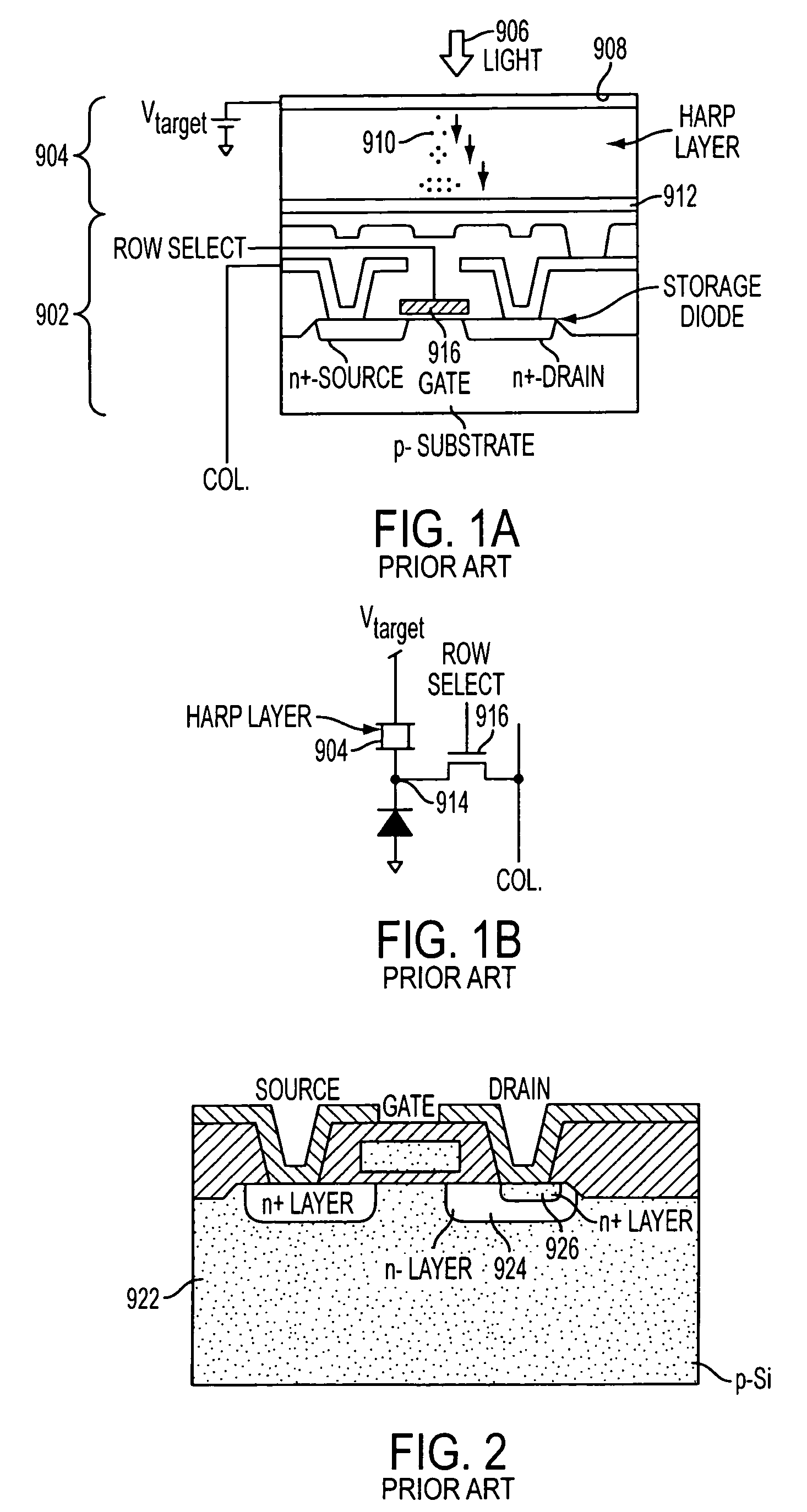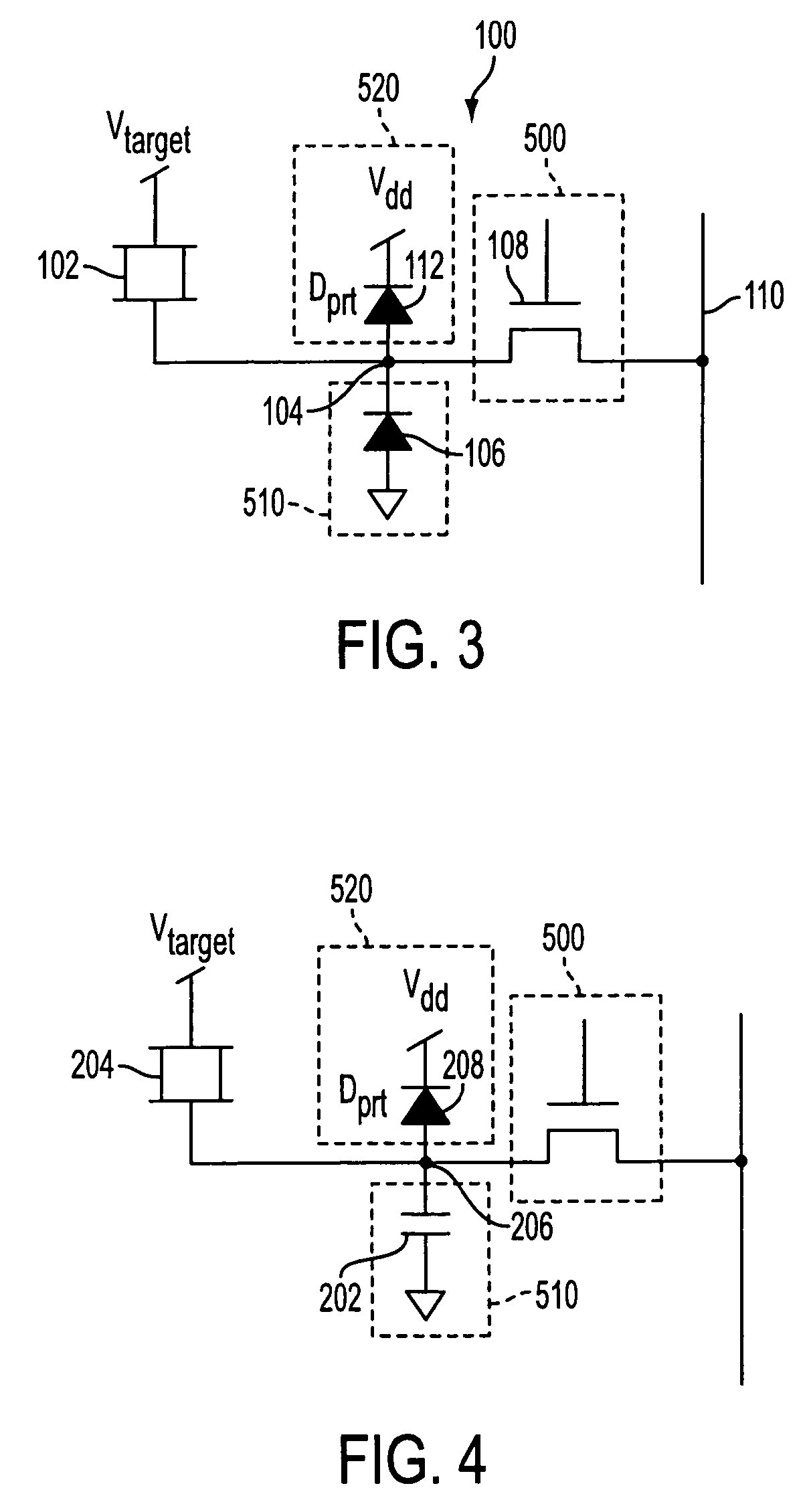CMOS APS with stacked avalanche multiplication layer and low voltage readout electronics
a multiplication layer and low voltage readout technology, applied in the field of image sensors, can solve the problems of reducing the sensitivity of the image sensor, reducing the size of the electronic circuit in the device, and the potential for obtaining blurred images, so as to achieve the effect of reducing the problem of high voltag
- Summary
- Abstract
- Description
- Claims
- Application Information
AI Technical Summary
Benefits of technology
Problems solved by technology
Method used
Image
Examples
first embodiment
[0027]A second preferred embodiment of the present invention is shown in FIG. 4, and is identical to the pixel circuit of the first embodiment except that the storage element 510 is embodied as a storage capacitor 202 instead of a storage diode. Preferably, storage capacitor 202 has a large capacitance value per unit area, even more preferably in the range of 2-5 fF / μ2. Such a capacitor provides a higher capacitance value while reducing the space required for the charge storage region, relative to the use of a storage diode.
[0028]In this embodiment, charge from the charge multiplying photoconversion layer 204 is stored in the capacitor 202, until the voltage at the capacitor 206 reaches Vdd. Additional voltage flowing to node 206 from the charge multiplying photoconversion layer 204 is then directed through the protection diode 208 of protection circuit 520 so that the charge stored in the capacitor 202 maintains a voltage of around Vdd.
[0029]A third preferred embodiment of the pres...
fifth embodiment
[0037]According to the present invention, as shown in FIG. 7, a differential amplifier 502 is connected to a constant voltage supply Vref at a positive input thereof, and the output is connected to a capacitor 504 in a feedback loop connecting to the negative input to the differential amplifier. A reset switch 506 is connected in parallel to the capacitor 504 between the negative input and the output of the differential amplifier 502 for shorting out the capacitor 504. A row select switch 508, which may be identical to the row select transistor 108 discussed above with reference to FIG. 3, is also connected to the output of the differential amplifier downstream of the connection to the capacitor 504.
[0038]During the integration time in this embodiment, hole current from the charge (hole) amplifying photoconversion layer is inputted to the negative input of the differential amplifier, through the differential amplifier and through the feedback loop. In this manner, the hole current f...
sixth embodiment
[0042]The output circuit is shown in FIG. 8, and is identical to the output circuit of FIG. 7, except that the output circuit of FIG. 8 converts the hole current from the charge amplifying photoconversion layer into a logarithmic signal, to account for the decreasing amplification level of the charge multiplying photoconversion layer due to the inverse relationship between the voltage level at the storage node and the effective Vtarget. In this regard, instead of a capacitor connected between the negative input and the output of the differential amplifier as shown in FIG. 7, the output circuit of FIG. 8 provides a feedback diode 604 having its anode connected to the negative input of the differential amplifier 602 and its cathode connected to the output of the differential amplifier 602. As configured in this manner, the output circuit of this embodiment thus logarithmically compresses the readout signal representing the intensity of the detected light.
PUM
 Login to View More
Login to View More Abstract
Description
Claims
Application Information
 Login to View More
Login to View More - R&D
- Intellectual Property
- Life Sciences
- Materials
- Tech Scout
- Unparalleled Data Quality
- Higher Quality Content
- 60% Fewer Hallucinations
Browse by: Latest US Patents, China's latest patents, Technical Efficacy Thesaurus, Application Domain, Technology Topic, Popular Technical Reports.
© 2025 PatSnap. All rights reserved.Legal|Privacy policy|Modern Slavery Act Transparency Statement|Sitemap|About US| Contact US: help@patsnap.com



